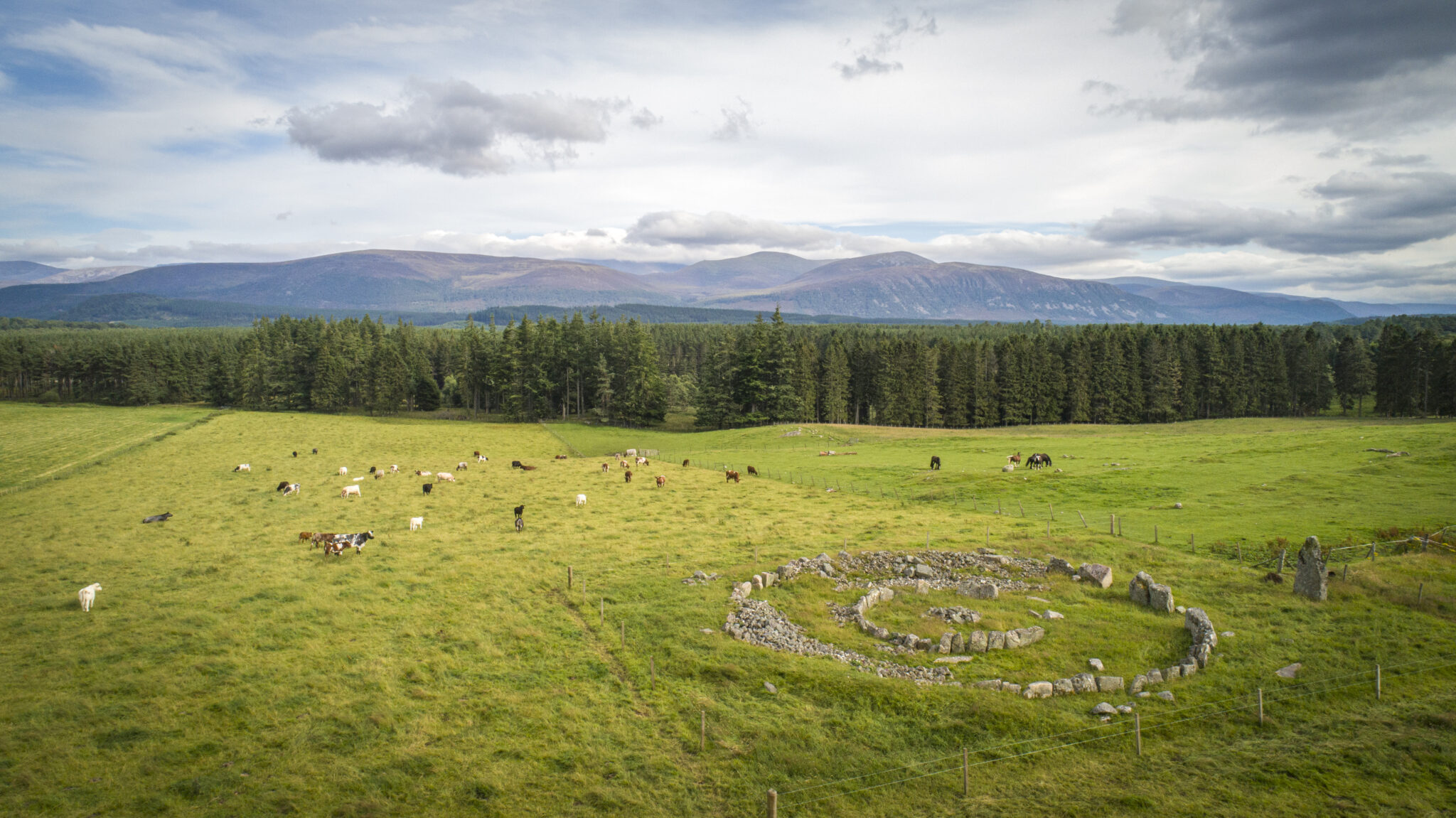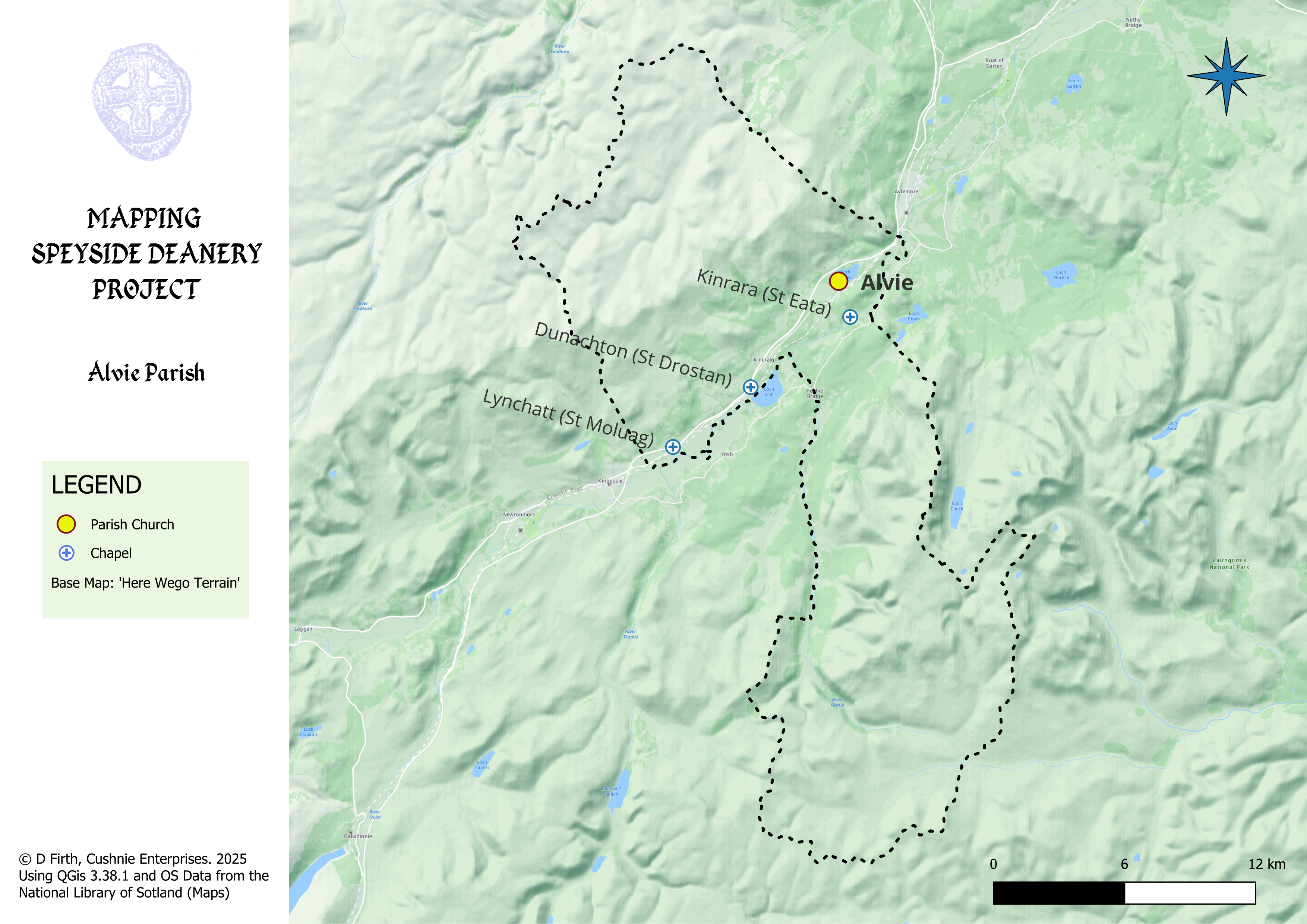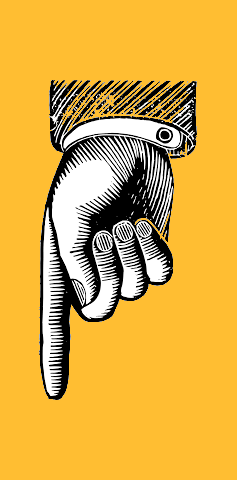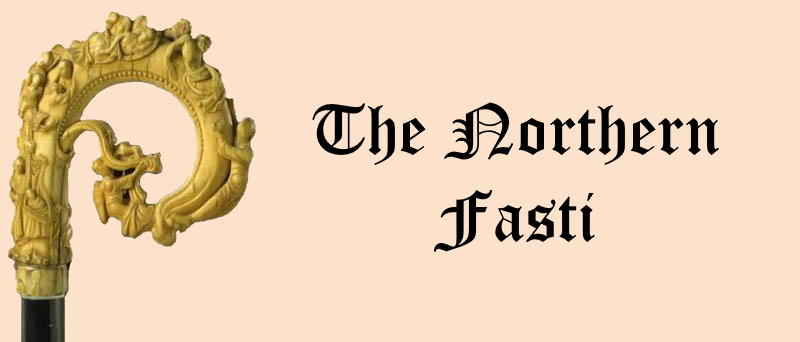Strathspey Deanery
Alvie
(Sgire Allmhuighe)
Parish Church: OS Ref: NGR NH 864093 H.E.S. No: NH80NE 17 Dedication: St Drostàn
Associated Chapels: Kinrara (St. Æth)
The area surrounding Loch Alvie abounds with archaeological remains which show that a significant population inhabited these lands in very early times. There is a prehistoric fort on the sumit of Torr Alvie

© James Stevens via Visit Caingorms.

© Mitchell & Noble.
The three parishes of Laggan, Kingussie and Alvie, together constitute that whole district distinguished by the famous appellation of Badenaugh, now known as Badenoch. Some would suggest that, throughout this area, there are still to be heard echoes of the footsteps and preaching of some of the earliest and most renowned Saints of the Early Church - Drostán, Moluag, Kenneth and Eata.
In old charters, such as those to be found in the Registrum Episcopatus Moraviensis, reference is often made to this church using an alternative name - Lochalveth - and readers should exercise caution.8
After 1331, when Thomas Randolph gave the patronage of the church of "Skeiralloway of Lochalvie" to the cathedral in Elgin (see below), the church itself remained in posession of the vicarage, whilst the rectory went to the Common Fund of the cathedral. A vicar perpetual provided for the 'cure' of the parish from this time onwards.
Shaw wrote that, "the church standeth near to a mile from the north end of the parish, on a peninsula of a lake called Loch Alvie."10 The church is surrounded by water on three sides - Loch Alvie on the west and north sides, and Loch Beag on the south - the site being to the west of the River Spey. The stipend, including the commuion allowance, was some £70 in 1882, and there was a glebe of nearly 2 acres of arable land and summer pastuarge for one cow. In these times there was also a parochial school attended by some 30 scholars.

© Mick Gerrard, 2007.
Barrow suggested that Alvie was an old thanage, perhaps having its centre in the dabhach of Dalnavert. It is also said that South Kinrara
The present church building was erected c.1768 on the site of an older church and it has been subject to alterations and re-building on a number of occastions since. It is of a simple rectangular design and is built of harled, coursed granite and is set within a circular rubble walled enclosure. Alvie Manse and the Glebe were purchased in 1936 and incorporated into the Alvie and Dalradie Estate.

© Dave Fergusson, 2010.
1333 (26 April) At Finlarig, John, bishop of Moray, addresses a 'precept' to Cristino, Vicar Perpetual of Lochalveth. "By virtue of your firm obedience, we now command the full investiture and corporeal possession of the aforesaid church of Lochalveth, vacant by the resignation of Mr Aymer de Wenton, the rector of the church for a while, to Mr. John de Dichton, procurator of the chaplains of the aforesaid cathedral church of Elgin, with all the rights and possessions faithfully delivered by our authority, which we specially commit to you by the presents. In witness whereof we send you these letters sealed with our seal. Given: at Fyndlargis [Finlarig] on Monday, the morrow of the feast of the blessed Mark the Evangelist in the year of the Lord, 1333."20
1350 (13 June) The Pope [Clement VI] confirms all that had been told him by John, bishop of Moray, including that Thomas Randolph, Earl of Moray, had given the patronage of the church of Lochalveth to the cathedral at Elgin in order to support the seventeen residential chaplains serving there.25
"John, bishop of Moray, who is a papal chaplain. Signification that in the church of Moray there are seventeen residentiary chaplains, who cannot live of their stipends, to whom the bishop, inaccordance withthe dean and chapter, appropriated two poor churches, which belonged to him, namely, Brounath and Altre [Birnie and Altyre], of his diocese, whose value together amounts to 40 pounds of Tours; also that Thomas Ranulphi, earl of Moray, did in his lifetime, with the bishop's consent, give the patronage of the church of Alveth [Alvie], in the said diocese, to the seventeen chaplains in augmentation of their rents, and at his instance the said bishop, in accordance with the dean and chapter, appropriated to the chaplains the said church of Alveth, whose value, all deductions being made, is no more than 20 pounds of Tours, vicars' portions for the three churches being reserved; the bishop therefore prays for confirmation of the said donations."
Granted. Avignon, Id. June, 135026
1380 (14 July) Alexander Stewart, Lord of Badenoch, lieutenant of the north, signs a charter at Ruthven confiring that the lands of Rothiemurchus, Logykenny, Kingussie, Inche and Ardinche, and the chapels of Raitt, and Nachtan and the land of the church of Kincardine, are held of the King as are any other churches in the diocese of Moray.80
1381 (28 October) By formal deed, the same Alexander, Lord of Badenoch (in time to become known as "the Wolf of Badenoch"), at his castle of Ruthven, quitclaims the lands of Logykenny, Ardynche (Ard-Inch), and the chapels of Raitt and Dunachton to the bishop of Moray, whilst in return, he received the vast domain of Rothiemurchus by assedation, dated at Elgin, 20th May 1383. Alexander had claimed that they were part of his lands of Badenoch whereas the bishop had claimed that they were episcopal lands.82
| No. | Name | OS Grid Ref. | Extent | Including | Notes |
|---|---|---|---|---|---|
| 1 | Dunachton: * | NH 858065 | 2 dabhaichean | Dunachton (Mor) & (Beg) | |
| 3 | Dalnavert: | NJ 147369 | 1 dabhach | ||
| 4 | Kynroraycht: * | c.NJ 87_07_ | 1 dabhach | (Kinraramoir) | |
| 5 | E. Lambulge: | 1 dabhach | |||
| NH 890111 | Kynnachil | ||||
| 6 | W. Lynwilg: | 1 dabhach | (Lynwilg = Lambulge) | ||
| c.NH 87_10_ | Rientomy | ||||
| Lynechrunie | |||||
| Rienaiull | |||||
| 7 | Pittiechiern: | c.NH 82_05_ | 1 dabhach | ||
| 8 | Pittourie: * | c.NH 79_03_ | 1 dabhach | ||
| 9 | Dellradie: | 1 dabhach | |||
| c.NH 80_05_ | Kinlachir | ||||
| Lynenrich | |||||
| Ballevullin | |||||
| Kyntarlim | |||||
| Knockicheillich | |||||
| Lynemoich | |||||
| Reichnoik | |||||
| Feavorer | |||||
| Riachnahegg | |||||
| Badbog | |||||
| 10 | Kincraig & Preselligh: | c.NH 83_05_ | 1 dabhach | ||
| 11 | Dalfour: | c.NH 84208_ | 1 dabhach | (East & West Dalfour) | |
| 12 | Easter Rait: | c.NH 80_03_ | 1 dabhach | ||
| 13 | Mid Rait: | 1 dabhach | |||
| 14 | Wester Rait: | c.NH 79_03_ | 1 dabhach | ||
| 15 | Kinraranakyll: * | c.NH 876082 | 1 dabhach | (South Kinrara) | |
| 16 | Invermarkie: | 1 dabhach | (Earl of Moray's) | ||
| Auchrilsuchain | |||||
| Ballelerue | |||||
| Croftisvuillen | |||||
| Tollivae | |||||
| Auchigufarlinne | |||||
| Ballenriech | |||||
| Ballenloan | |||||
| Tomnariback | |||||
| Clasdou | |||||
| Achguisichan | |||||
| NN 852976 | Achleanbeg | ||||
| Gortinachraich | ½ dabhach | (Part of Kinrara) | |||
| Inverouries | ½ dabhach | ||||
| Pettewrie | ½ dabhach | ||||
| Wester Lambulge | ½ dabhach | ||||
| Mid Rait | ½ dabhach | ||||
| Little Dunachton | ½ dabhach | ||||
| Dunachtonmore | ½ dabhach | ||||
| Kerrowdow | ¼ dabhach | ||||
| Information from Ross (2003).90 Locations by David at Cushnie Enterprises. | |||||
| Lands marked with an (*) were part of the Castle Lands of Inverness. | |||||

© James Stevens via Visit Caingorms.
Alasdair Ross says "there were two dabhaichean here - Kinroraycht (Kinraramoir), which was part of the castle lands of Inverness; and Kinraranakyll (South Kinrara) which, by its name, is obviously linked with a church, but which also formed part of the castle lands of Inverness.105
The nearby House of Belleville is said to occupy the site of Rait Castle which was one of the chief ancient strongholds of the Comyn family in Badenoch.116
Dunachton has a most ancient history. It was the caput of an extensive barony which stretched from the River Spey over the mountains, across the valley of the Dulnain on to the Monadhliath Mountain range, and onwards to the watershed of the River Findhorn. This vast estate was the home of Clan Mackintosh for hundreds of years and there was a castle built at Dunachton which was destroyed, as was the House of Dunachton that was built as a replacement. Eventually, thistoo was replaced by Dunachton Lodge. In later times, when one of the lairds purchased a residence in Inverness, he called it "Dunachton". There have been a number of Mackintosh lairds who have carried the title "Baron Dunachton".130 The antiquity of the site is revealed by the presence of a Class 1 Pictish symbol stone. Found in 1870, when a steading of Dunachton Lodge was being demolished, it bears a single symbol - a deer's head - and it had been used as a door-lintel in the old building.
In 1690, Parliament passed an Act granting the laird permission to hold "a weekly market at the town of Dunachton in Badenoch, to be holden each Wednesday, and erects the said town of Dunachton into a burgh of Barony".135

© RCAHMS.
2. "Dig It!: Top six archaeological sites and discoveries in Badenoch in the Cairngorms," Society of Antiquaries of Scotland. https://www.digitscotland.com/top-six-archaeological-sites-and-discoveries-in-badenoch-in-the-cairngorms/
4. Mitchell & Noble (2017), p. 20. Return to Text
8. R.E.M., no. 225, p. 289, is but one example of this. Return to Text
10. Shaw, L. (1882), i., p. 277. Return to Text
12. Shaw, L. (1882), i., p. 283. Return to Text
18. Information from Alvie Estates, 2018. Return to Text
20. R.E.M., no. 225, p. 289. Return to Text
25. R.E.M., no. 227, p. 290-293. Return to Text
26. C.P.P., i., p. 200. Return to Text
80. R.E.M., no. 159, pp. 183-187. Return to Text
82. R.E.M., no. 161, pp. 188-189. Return to Text
90. Ross (2003), ii., p. 126-127. Return to Text
100. Mackinlay (1914), p. 241. Return to Text
105. Ross (2003), ii., p. 126-7. Return to Text
110. Mackinlay (1914), p. 160. Return to Text
115. Shaw (1882), i., p. 280. Return to Text
116. Shaw (1882), i., p. 283. Return to Text
120. Shaw (1882), i., p. 278. Return to Text
122. Barrow (1988), p. 8. Return to Text
125. Fraser-Mackintosh (1866), p. 2. Return to Text
130. Fraser-Mackintosh (1866), p. 6. "Lachlan, 14th Chief of Mackintosh, younger brother of William Mackintosh of Dunachton, married in 1520 Jean Gordon, heiress of the line of the Knights of Lochinvar." Return to Text
135. Fraser-Mackintosh (1866), p. 13. Return to Text
Barrow, G.S. (1988) 'Badenoch & Strathspey, 1130-1312', in Northern Scotland, Vol. 8.
Bliss, W.H. et al (1896) Calendar of entries in the Papal registers relating to Great Britain and Ireland: Petitions to the Pope, Volume I, A.D. 1342-1419, London: H.M. Stationery Office. [C.P.P., i.] https://archive.org/details/calendarentries00blisgoog
Chalmers, G. (1807) Caledonia or an Account, Historical and Topgraphic, of North Britain; from the most ancient to the present times: with a Dictionary of Places, Edinburgh: A. Constable. https://books.google.co.uk/books?id=_JiPwwEACAAJ&pg=PA115&source=gbs_toc_r&cad=2#v=onepage&q=Cromdale&f=false
Clancy, T.O. (1995) 'Annat in Scotland', Edinburgh: Innes Review, No. 46., Vol. 2., pp. 91-115.
Fawcett, R. and Oram, R. (2014) Elgin Cathedral and the Diocese of Moray, Edinburgh, Historic Scotland. Return to Text.
Forsyth, W. (1900) In the Shadow of Cairngorm: Chronicles of the united parishes of Abernethy and Kincardine, Inverness: The Northern Counties Publishing Company, Ltd. https://ia601605.us.archive.org/25/items/inshadowcairngo00forsgoog/inshadowcairngo00forsgoog.pdf
Fraser, Wm. (1883) The Chiefs of Grant, Edinburgh. Published by the Grant family in 3 volumes.
Fraser-Mackintosh of Drummond, C. (1866) Dunachton Past and Present, Inverness: Printed at the Advertiser Office. (Only fourty copies were printed.)https://archive.org/details/dunachtonpastpre1866mack
Innes, C. (1837) Registrum Episcopatus Moraviensis: e pluribus codicibus consarcinatum virca A.D. MCCCC, cum continuatione diplomatum recentiorum usque ad A.D. MDCVVIII, Edinburgh: for the Bannatyne Club. [R.E.M.]
MacDonald, A. (1973) '"Annat" in Scotland: A Provisional Review', Scottish Studies, 17 (1973), pp. 135-146.
Mackinlay, J.M. (1914) Ancient Church Dedications in Scotland: Volume 2, Non-Scriptural Dedications, Edinburgh: David Douglas.
Mitchell, J. & Noble, G. (2017) 'The Monumental Cemeteries of Northern Pictland', Medieval Archaeology, vol. 61:1, p. 1-40. http://dx.doi.org/10.1080/00766097.2017.1296031
Shaw, L., (1882) The History of the Province of Moray, Glasgow: Hamilton, Adams, & Co. New Edition in three volumes.
Shead, N.F., (2015) Scottish Episcopal Acta, Volume 1: The Twelfth Century, [Scottish History Society, 6th Series, Volume 10], Woodbridge, Suffolk: The Boydell Press. [S.E.A., i.]
Stringer, K., (ed.) (waiting publication) Regesta Regum Scottorum III: The Acts of Alexander II, King of Scots, 1214-1249, Edinburgh: Edinburgh University Press. [R.R.S., iii.]
Theses.
Ross, A.D. (2003) The Province of Moray, c.1000-1230, unpublished PhD thesis presented to Aberdeen University, 2 volumes.
e-mail: admin@cushnieent.com
© 2023 Cushnie Enterprises


